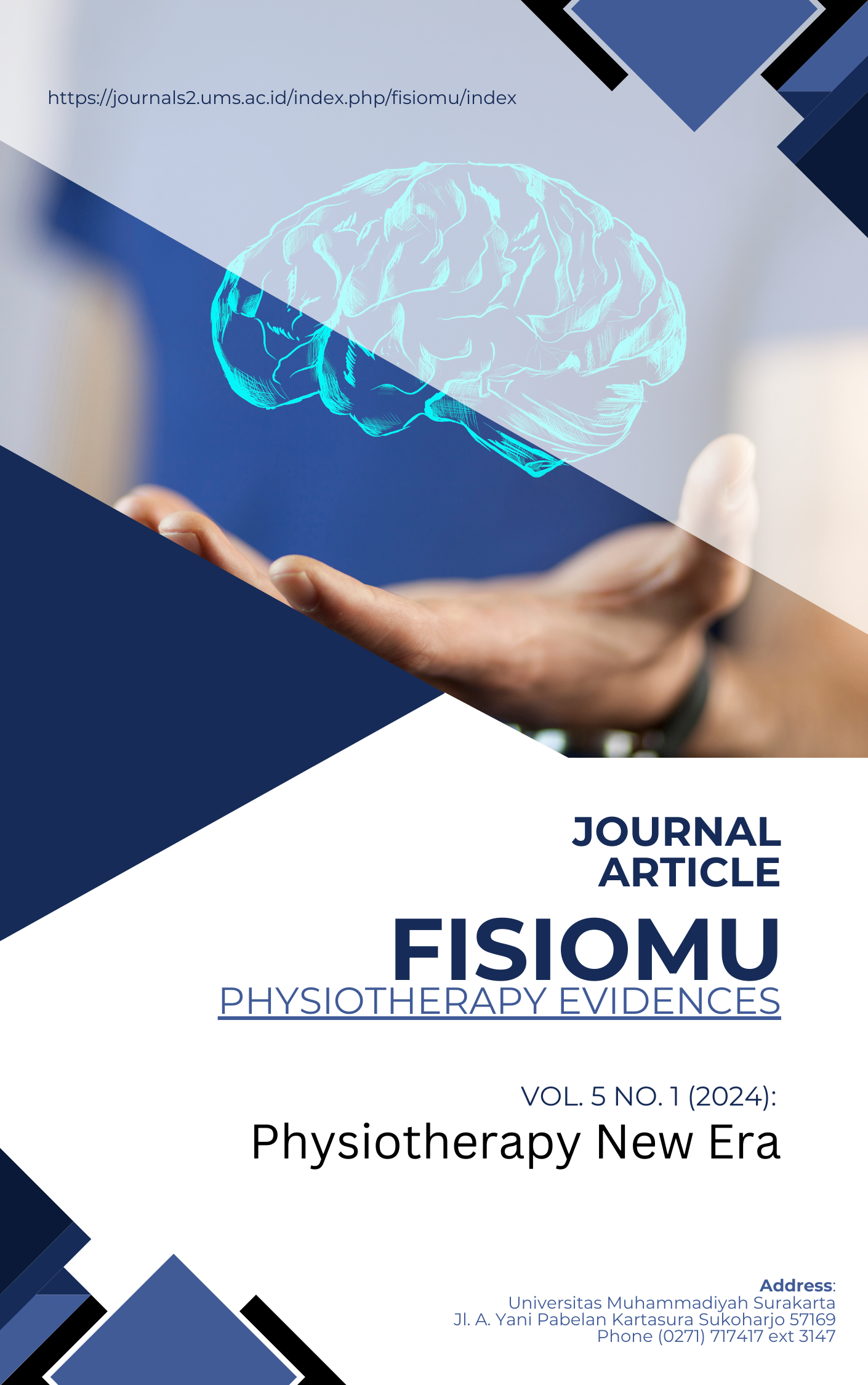The Effect of Stretching and Strengthening Exercises on Reducing Pain and Functional Disorders in Subacromial Pain Syndrome: A Literature Review
DOI:
https://doi.org/10.23917/fisiomu.v5i1.2280Keywords:
physiotherapy, Subacromial pain syndrome, pain, functional disorder, stretching, strengtheningAbstract
Introduction: Shoulder pain is the third most common pain in musculoskeletal cases, after lower back and knee pain. These complaints are caused by various things, including subacromial pain syndrome. Subacromial pain syndrome is a synonym for rotator cuff syndrome, which refers to all non-traumatic unilateral shoulder problems involving the structures surrounding the subacromial. The purpose of this study was to determine the effect of stretching and strengthening exercises on reducing pain and functional impairment in subacromial pain syndrome. Methods: The method used is a literature review with a narrative type. The data for the selected publication articles are RCTs for 2013-2022 in English. Search publication articles using search PEDro, and Google Scholar which are classified into inclusion and exclusion criteria. Data analysis by assessing the quality of journals using the PEDro scale, outline literature review of the PICO method and data synthesis. Results: Strengthening and stretching exercises show significant short-term functional improvement and pain reduction in subacromial pain syndrome. Additionally, specific rotator cuff and scapular exercises, combined with active/passive ROM exercises, significantly enhance function and reduce pain levels. Conclusion: Strengthening (eccentric, isometric) and stretching exercises on the posterior shoulder and rotator cuff or scapular in the short term have an effect on reducing pain (VAS), as well as a significant improvement in function (DASH scale).
Downloads
References
Abdulla, S. Y., Southerst, D., Côté, P., Shearer, H. M., Sutton, D., Randhawa, K., Varatharajan, S., Wong, J. J., Yu, H., Marchand, A. A., Chrobak, K., Woitzik, E., Shergill, Y., Ferguson, B., Stupar, M., Nordin, M., Jacobs, C., Mior, S., Carroll, L. J., … Taylor-Vaisey, A. (2015). Is exercise effective for the management of subacromial impingement syndrome and other soft tissue injuries of the shoulder? A systematic review by the Ontario Protocol for Traffic Injury Management (OPTIMa) Collaboration. Manual Therapy, 20(5), 646–656. https://doi.org/10.1016/j.math.2015.03.013
Bhattacharyya, R., Edwards, K., & Wallace, A. W. (2014). Does arthroscopic sub-acromial decompression work for sub-acromial impingement syndrome: A cohort study. BMC Musculoskeletal Disorders, 15(1), 1–7. https://doi.org/10.1186/1471-2474-15-324
Bijur, P. E., Silver, W., & Gallagher, E. J. (2001). Reliability of the visual analogue scale for the measurement of acute pain. Academic Emergency Medicine, 8(12), 1153–1157. https://doi.org/10.1111/j.1553-2712.2001.tb01132.x
Chaconas, E. (2015). University of St Augustine for Health Sciences SOAR @ USA Shoulder External Rotator Eccentric Training For Subacromial Pain Syndrome.
Delgado, D. A., Lambert, B. S., Boutros, N., McCulloch, P. C., Robbins, A. B., Moreno, M. R., & Harris, J. D. (2018). Validation of Digital Visual Analog Scale Pain Scoring With a Traditional Paper-based Visual Analog Scale in Adults. JAAOS: Global Research and Reviews, 2(3), e088. https://doi.org/10.5435/jaaosglobal-d-17-00088
Franchignoni, F., Vercelli, S., Giordano, A., Sartorio, F., Bravini, E., & Ferriero, G. (2014). Minimal clinically important difference of the disabilities of the arm, shoulder and hand outcome measure (DASH) and its shortened version (quickDASH). Journal of Orthopaedic and Sports Physical Therapy, 44(1), 30–39. https://doi.org/10.2519/jospt.2014.4893
Gutiérrez-espinoza, H., Araya-quintanilla, F., & Gutiérrez-monclus, R. (2019). Musculoskeletal Science and Practice Does pectoralis minor stretching provide additional benefit over an exercise program in participants with subacromial pain syndrome ? A randomized controlled trial. Musculoskeletal Science and Practice, 44(April), 102052. https://doi.org/10.1016/j.msksp.2019.102052
Haik, M. N., Vieira, M. S. A., & Salvini, M. S. T. F. (2015). research report ]. 45(270), 984–997. https://doi.org/10.2519/jospt.2015.5939
Hanratty, C. E., Mcveigh, J. G., Kerr, D. P., Basford, J. R., Finch, M. B., Pendleton, A., & Sim, J. (2012). The Effectiveness of Physiotherapy Exercises in Subacromial Impingement Syndrome : A Systematic Review and Meta-Analysis. YSARH, 42(3),297–316. https://doi.org/10.1016/j.semarthrit.2012.03.015
Ingwersen, K. G., Jensen, S. L., Sørensen, L., Jørgensen, H. R., Christensen, R., Søgaard, K., Juul-kristensen, B., & Prof, A. (2017). Three Months of Progressive High-Load Versus Traditional Low-Load Strength Training Among Patients With Rotator Cuff Tendinopathy Primary Results From the Double-Blind Randomized Controlled RoCTEx Trial. 1–19. https://doi.org/10.1177/2325967117723292
Klimek, L., Bergmann, K. C., Biedermann, T., Bousquet, J., Hellings, P., Jung, K., Merk, H., Olze, H., Schlenter, W., Stock, P., Ring, J., Wagenmann, M., Wehrmann, W., Mösges, R., & Pfaar, O. (2017). Visual analogue scales (VAS) - Measuring instruments for the documentation of symptoms and therapy monitoring in case of allergic rhinitis in everyday health care. Allergo Journal, 26(1), 36–47. https://doi.org/10.1007/s40629-016-0006-7
Michener, L. A., Subasi Yesilyaprak, S. S., Seitz, A. L., Timmons, M. K., & Walsworth, M. K. (2015). Supraspinatus tendon and subacromial space parameters measured on ultrasonographic imaging in subacromial impingement syndrome. Knee Surgery, Sports Traumatology, Arthroscopy, 23(2), 363–369. https://doi.org/10.1007/s00167-013-2542-8
Moseley, A. M., Elkins, M. R., Wees, P. J. Van Der, & Pinheiro, M. B. (2019). Brazilian Journal of Using research to guide practice : The physiotherapy evidence database ( PEDro ). Brazilian Journal of Physical Therapy, xx. https://doi.org/10.1016/j.bjpt.2019.11.002
Moslehi, M., Letafatkar, A., & Miri, H. (2020). Feedback improves the scapular-focused treatment effects in patients with shoulder impingement syndrome. Knee Surgery, Sports Traumatology, Arthroscopy, 0123456789. https://doi.org/10.1007/s00167-020-06178-z
Nejati, P., Ghahremaninia, A., Naderi, F., Gharibzadeh, S., & Mazaherinezhad, A. (2017). Treatment of subacromial impingement syndrome: Platelet-rich plasma or exercise therapy?: A randomized controlled trial. Orthopaedic Journal of Sports Medicine, 5(5), 1–2. https://doi.org/10.1177/2325967117702366
Reijneveld, E. A. E., Noten, S., Michener, L. A., Cools, A., & Struyf, F. (2017). Clinical outcomes of a scapular-focused treatment in patients with subacromial pain syndrome : a systematic review. 436–441. https://doi.org/10.1136/bjsports-2015-095460
The report, O. (2021). Guided Exercises With Or Without Joint Mobilization Or No Treatment In Patients With Subacromial Pain Syndrome : A Clinical. 8. https://doi.org/10.2340/16501977-2806
Rosadi, R., Mabrur, A., Sunaringsih, S., & Wardojo, I. (2021). Pelaksanaan Fisioterapi Komunitas Dalam Upaya Meningkatkan Kesadaran Tentang Cedera Olahraga Pada Pemain Bola Voli Putri Generasi Muda Juata Laut. 7(2), 242–246.
Saito, H., Harrold, M. E., Cavalheri, V., & Mckenna, L. (2018). Scapular focused interventions to improve shoulder pain and function in adults with subacromial pain : A systematic review and meta-analysis. Physiotherapy Theory and Practice, 00(00),1–18. https://doi.org/10.1080/09593985.2018.1423656
Shire, A. R., Stæhr, T. A. B., Overby, J. B., Dahl, M. B., Jacobsen, J. S., & Christiansen, D. H. (2017). Specific or general exercise strategy for subacromial impingement syndrome – does it matter ? A systematic literature review and meta-analysis. 1–18. ttps://doi.org/10.1186/s12891- 017-1518-0
Singla, D., & Veqar, Z. (2017). Association Between Forward Head, Rounded Shoulders, and Increased Thoracic Kyphosis: A Review of the Literature. Journal of Chiropractic Medicine, 16(3), 220–229. https://doi.org/10.1016/j.jcm.2017.03.004
Snyder, H. (2019). Literature review as a research methodology : An overview and guidelines. Journal of Business Research, 104(March), 333–339. https://doi.org/10.1016/j.jbusres.2019.07.039
Tahran, Ö., & Yes, S. S. (2020). Effects of Modified Posterior Shoulder Stretching Exercises on Shoulder Mobility, Pain, and Dysfunction in Patients With. X(X). https://doi.org/10.1177/1941738119900532
Thigpen, C. A., Shaffer, M. A., Gaunt, B. W., Leggin, B. G., Williams, G. R., & Wilcox, R. B. (2016). The American Society of Shoulder and Elbow Therapists’ consensus statement on rehabilitation following arthroscopic rotator cuff repair. Journal of Shoulder and Elbow Surgery, 25(4), 521– 535. https://doi.org/10.1016/j.jse.2015.12.018
Tomás-rodríguez, M. I., & Nouni-garcía, R. (2017). Effectiveness of a Group Physiotherapy Intervention in Nontraumatic, Inoperable Painful Shoulder. 00(00), 1–6. https://doi.org/10.1097/PHM.0000000000000817
Downloads
Submitted
Accepted
Published
How to Cite
Issue
Section
License
Copyright (c) 2023 Fisio Mu : Physiotherapy Evidaces Journal

This work is licensed under a Creative Commons Attribution-NonCommercial-NoDerivatives 4.0 International License.

This work is licensed under a Creative Commons Attribution-NonCommercial 4.0 International License.
Authors who publish with FISIO MU: Phsiotherapy Evidences agree to the following terms:
- Author(s) retain copyright and grant the journal right of first publication with the work simultaneously licensed under a Creative Commons Attribution-NonCommercial 4.0 International License that allow others to share the work within an acknowledgement of the work’s authorship and initial publication of this journal.
- Author(s) are able to enter into separate, additional contractual arrangement for the non-exclusive distribution of the the journal’s published version of the work (e.g. acknowledgement of its initial publication in this journal).
- Author(s) are permitted and encouraged to post their work online (e.g. in institutional repositories or on their websites) prior to and during the submission process, as it can lead to productive exchanges, as well as earlier and greater citation of published works.












